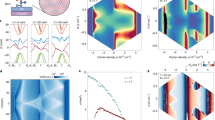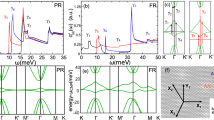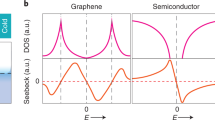Abstract
The identification and characterization of spontaneous symmetry breaking is central to our understanding of strongly correlated two-dimensional materials. In this work, we utilize the angle-resolved measurements of transport non-reciprocity to investigate spontaneous symmetry breaking in twisted trilayer graphene. By analysing the angular dependence of non-reciprocity in both longitudinal and transverse channels, we are able to identify the symmetry axis associated with the underlying electronic order. We report that a hysteretic rotation in the mirror axis can be induced by thermal cycles and a large current bias, supporting the spontaneous breaking of rotational symmetry. Moreover, the onset of non-reciprocity with decreasing temperature coincides with the emergence of orbital ferromagnetism. Combined with the angular dependence of the superconducting diode effect, our findings uncover a direct link between rotational and time-reversal symmetry breaking. These symmetry requirements point towards exchange-driven instabilities in momentum space as a possible origin for transport non-reciprocity in twisted trilayer graphene.
This is a preview of subscription content, access via your institution
Access options
Access Nature and 54 other Nature Portfolio journals
Get Nature+, our best-value online-access subscription
$29.99 / 30 days
cancel any time
Subscribe to this journal
Receive 12 print issues and online access
$259.00 per year
only $21.58 per issue
Buy this article
- Purchase on Springer Link
- Instant access to full article PDF
Prices may be subject to local taxes which are calculated during checkout




Similar content being viewed by others
Data availability
Data presented in this work are attached. Source data are provided with this paper. Additional data are available from the corresponding author upon request.
References
Fradkin, E., Kivelson, S. A., Lawler, M. J., Eisenstein, J. P. & Mackenzie, A. P. Nematic Fermi fluids in condensed matter physics. Annu. Rev. Condens. Matter Phys. 1, 153–178 (2010).
Oganesyan, V., Kivelson, S. A. & Fradkin, E. Quantum theory of a nematic Fermi fluid. Phys. Rev. B 64, 195109 (2001).
Kivelson, S. A., Fradkin, E. & Emery, V. J. Electronic liquid-crystal phases of a doped Mott insulator. Nature 393, 550–553 (1998).
Wu, J., Bollinger, A., He, X. & Božović, I. Spontaneous breaking of rotational symmetry in copper oxide superconductors. Nature 547, 432–435 (2017).
Wu, J. et al. Electronic nematicity in Sr2RuO4. Proc. Natl Acad. Sci. USA 117, 10654–10659 (2020).
Ando, Y., Segawa, K., Komiya, S. & Lavrov, A. N. Electrical resistivity anisotropy from self-organized one dimensionality in high-temperature superconductors. Phys. Rev. Lett. 88, 137005 (2002).
Hinkov, V. et al. Electronic liquid crystal state in the high-temperature superconductor YBa2Cu3O6.45. Science 319, 597–600 (2008).
Jiang, Y. et al. Charge order and broken rotational symmetry in magic-angle twisted bilayer graphene. Nature 573, 91–95 (2019).
Choi, Y. et al. Electronic correlations in twisted bilayer graphene near the magic angle. Nat. Phys. 15, 1174–1180 (2019).
Kerelsky, A. et al. Maximized electron interactions at the magic angle in twisted bilayer graphene. Nature 572, 95–100 (2019).
Cao, Y. et al. Nematicity and competing orders in superconducting magic-angle graphene. Science 372, 264–271 (2021).
Rubio-Verdú, C. et al. Moiré nematic phase in twisted double bilayer graphene. Nat. Phys. 18, 196–202 (2022).
Zhang, N. J., Watanabe, K., Taniguchi, T., Vafek, O. & Li, J. I. A. Electronic anisotropy in magic-angle twisted trilayer graphene. Preprint at https://arxiv.org/abs/2211.01352 (2022).
Lin, J.-X. et al. Spontaneous momentum polarization and diodicity in Bernal bilayer graphene. Preprint at https://arxiv.org/abs/2302.04261 (2023).
Dong, Z., Davydova, M., Ogunnaike, O. & Levitov, L. Isospin- and momentum-polarized orders in bilayer graphene. Phys. Rev. B 107, 075108 (2023).
Jung, J., Polini, M. & MacDonald, A. H. Persistent current states in bilayer graphene. Phys. Rev. B 91, 155423 (2015).
Huang, C. et al. Spin and orbital metallic magnetism in rhombohedral trilayer graphene. Phys. Rev. B 107, L121405 (2023).
Vafek, O. Anisotropic resistivity tensor from disk geometry magnetoconductance. Phys. Rev. Applied 20, 064008 (2023).
Zondiner, U. et al. Cascade of phase transitions and Dirac revivals in magic-angle graphene. Nature 582, 203–208 (2020).
Park, J. M., Cao, Y., Watanabe, K., Taniguchi, T. & Jarillo-Herrero, P. Flavour Hund’s coupling, Chern gaps and charge diffusivity in moiré graphene. Nature 592, 43–48 (2021).
Xie, M. & MacDonald, A. H. Weak-field Hall resistivity and spin-valley flavor symmetry breaking in magic-angle twisted bilayer graphene. Phys. Rev. Lett. 127, 196401 (2021).
Kang, J., Bernevig, B. A. & Vafek, O. Cascades between light and heavy fermions in the normal state of magic-angle twisted bilayer graphene. Phys. Rev. Lett. 127, 266402 (2021).
Liu, X., Zhang, N., Watanabe, K., Taniguchi, T. & Li, J. Coulomb screening and thermodynamic measurements in magic-angle twisted trilayer graphene. Nat. Phys. 18, 522–527 (2022).
Lin, J.-X. et al. Spin-orbit–driven ferromagnetism at half moiré filling in magic-angle twisted bilayer graphene. Science 375, 437–441 (2022).
Ma, Q. et al. Observation of the nonlinear Hall effect under time-reversal-symmetric conditions. Nature 565, 337–342 (2019).
Kang, K., Li, T., Sohn, E., Shan, J. & Mak, K. F. Nonlinear anomalous Hall effect in few-layer WTe2. Nat. Mater. 18, 324–328 (2019).
He, P. et al. Graphene moiré superlattices with giant quantum nonlinearity of chiral Bloch electrons. Nat. Nanotechnol. 17, 378–383 (2022).
Sinha, S. et al. Berry curvature dipole senses topological transition in a moiré superlattice. Nat. Phys. 18, 765–770 (2022).
Khalaf, E., Kruchkov, A. J., Tarnopolsky, G. & Vishwanath, A. Magic angle hierarchy in twisted graphene multilayers. Phys. Rev. B 100, 085109 (2019).
Hao, Z. et al. Electric field–tunable superconductivity in alternating-twist magic-angle trilayer graphene. Science 371, 1133–1138 (2021).
Novoselov, K. S. et al. Electric field effect in atomically thin carbon films. Science 306, 666–669 (2004).
Novoselov, K. S. et al. Two-dimensional gas of massless Dirac fermions in graphene. Nature 438, 197–200 (2005).
Geim, A. K. & Grigorieva, I. V. Van der Waals heterostructures. Nature 499, 419–425 (2013).
Novoselov, K., Mishchenko, A., Carvalho, A. & Neto, A. C. 2D materials and van der Waals heterostructures. Science 353, aac9439 (2016).
Ajayan, P., Kim, P. & Banerjee, K. Two-dimensional van der Waals materials. Phys. Today 69, 38–44 (2016).
Sharpe, A. L. et al. Emergent ferromagnetism near three-quarters filling in twisted bilayer graphene. Science 365, 605–608 (2019).
Serlin, M. et al. Intrinsic quantized anomalous Hall effect in a moiré heterostructure. Science 367, 900–903 (2020).
Chen, S. et al. Electrically tunable correlated and topological states in twisted monolayer–bilayer graphene. Nat. Phys. 17, 374–380 (2021).
Polshyn, H. et al. Electrical switching of magnetic order in an orbital Chern insulator. Nature 588, 66–70 (2020).
Cheung, P., Bao, Z.-Q. & Zhang, F. Flavor symmetry and ferroelectric nematics in transition metal dichalcogenides. Preprint at https://arxiv.org/abs/1805.06493 (2018).
Lin, J.-X. et al. Zero-field superconducting diode effect in twisted trilayer graphene. Nat. Phys. 18, 1221–1227 (2022).
Scammell, H. D., Li, J. & Scheurer, M. S. Theory of zero-field superconducting diode effect in twisted trilayer graphene. 2D Mater. 9, 025027 (2022).
Benyamini, A. et al. Fragility of the dissipationless state in clean two-dimensional superconductors. Nat. Phys. 15, 947–953 (2019).
Acknowledgements
J.I.A.L. wishes to thank O. Vafek and D. Feldman for stimulating discussions. L.F. thanks the organizers of the workshop ‘Superconducting diode effects’ on Virtual Science Forum, which ignited the collaboration. This material is based on the work supported by the Air Force Office of Scientific Research under award no. FA9550-23-1-0482. N.J.Z. acknowledges support from the Jun-Qi fellowship and the Air Force Office of Scientific Research. J.-X.L. and J.I.A.L. acknowledge funding from NSF DMR-2143384. Device fabrication was performed in the Institute for Molecular and Nanoscale Innovation at Brown University. D.V.C. acknowledges financial support from the National High Magnetic Field Laboratory through a Dirac Fellowship, which is funded by the National Science Foundation (grant no. DMR-1644779) and the State of Florida. K.W. and T.T. acknowledge support from the Elemental Strategy Initiative conducted by the MEXT, Japan (grant no. JPMXP0112101001), and JSPS KAKENHI (grant nos. 19H05790, 20H00354 and 21H05233). The work at the Massachusetts Institute of Technology was supported by a Simons Investigator Award from the Simons Foundation.
Author information
Authors and Affiliations
Contributions
N.J.Z. and J.I.A.L. conceived the project. N.J.Z. and Y.W. fabricated the device. N.J.Z., J.-X.L. and Y.W. performed the measurement. D.V.C. and L.F. provided theoretical inputs. K.W. and T.T. provided the material. N.J.Z., L.F. and J.I.A.L. wrote the manuscript.
Corresponding author
Ethics declarations
Competing interests
The authors declare no competing interests.
Peer review
Peer review information
Nature Materials thanks the anonymous reviewers for their contribution to the peer review of this work.
Additional information
Publisher’s note Springer Nature remains neutral with regard to jurisdictional claims in published maps and institutional affiliations.
Extended data
Extended Data Fig. 1 Measurement setup.
(a-h) Schematic diagram showing the measurement configuration with current flowing is different azimuth directions ϕ across the ‘sunflower’ sample. For each ϕ, the longitudinal transport response is defined as the voltage difference across two contacts (each contact resembles a petal of the ‘sunflower’), which are aligned parallel to the direction of current flow. Panels (a) to (h) show measurement configurations for 8 azimuth directions. Along the same vein, the transverse response is measured across two contacts aligned perpendicular to the current flow direction, as shown in panel (i). We use V∥ (V⊥) to denote the voltage difference across two contacts that are parallel (perpendicular) to the current flow direction (Fig. 1a). Instead of applying current bias at the source contact and short to ground at the drain contact, we apply a positive current bias to the source contact, and a negative bias to the drain contact. This ensures that the center of the sample remains at zero electric potential, thus suppressing the potential influence of capacitive coupling and thermal-electric effects associated with the contact resistance.
Extended Data Fig. 2 Current-induced Hysteresis in nonreciprocity.
(a) The angular dependence of nonreciprocity measured at the same moiré band filling ν = − 0.3 and different current bias. At a small current bias, the angular dependence is best described by a one-fold symmetric cosine function. With increasing current, the angular dependence starts to evolves into a mixture between one- and three-fold at I > 200 nA. Further increasing the current bias gives rise to angular dependence at I = 400 nA that is best captured by \(\cos 3\phi\). (b) The angular dependence of nonreciprocity at ν = − 2.2 before (top panel) and after (bottom panel) the application of a large current bias. The large current bias induces a hysteretic rotation in the underlying mirror axis, which is marked by the green solid line in the polar coordinate plots. (c) \({R}_{\perp }^{2\omega }\), defined as \({V}_{\perp }^{2\omega }\)/I, as a function of current bias. As the current bias is swept back and forth, \({R}_{\perp }^{2\omega }\) exhibits a hysteresis loop. The angular dependence of \({V}_{\perp }^{2\omega }\) in panel (b) is measured before and after this hysteresis loop at a fixed current bias of I = 100 nA. Inset shows the schematic angular dependence for the data shown in panel (b).
Extended Data Fig. 3 Angle dependence of η∥ measured at different DC current bias.
Polar-coordinate plot of the angle dependence of η||, measured at B = 0, T = 20 mK and ν = 0.2. With increasing DC current bias, a similar angular dependence that is predominantly one-fold symmetric is observed up to IDC = 100 nA, all pointing towards around 140∘.
Extended Data Fig. 4 Nonreciprocity and nonlinearity.
(a) Current-voltage characteristic measured at ν = − 0.3 with DC current flowing along azimuth angle of ϕ = 0∘. The black dashed line is a linear fit to the portion of the IV curve near zero current bias. (b) The nonreciprocal component of the IV curve, which is extracted by subtracting the ohmic component of the transport response, η/2 = V∥ − IDCR0. R0 denotes the slope of the IV curve at IDC = 0 The solid line is a quadratic fit to the current dependence of η/2.
Extended Data Fig. 5 Second-harmonic nonlinear response and transport nonreciprocity.
Angle dependence measurement of (a) \({V}_{\parallel }^{2\omega }\) and (b) η|| at ν = 0.25 and (c) \({V}_{\parallel }^{2\omega }\) and (d) ηR at ν = 2.14. The remarkable match in the angle dependence between \({V}_{\parallel }^{2\omega }\) and (b) η|| at different densities illustrates their correspondence relation. \({V}_{\parallel }^{2\omega }\) are measured at IAC = 100 nA, ηR are measured at IDC = 100 nA. All measurements are performed at B = 0 and T = 20 mK.
Extended Data Fig. 6 Relative Root Mean Squared Error in the angular fit with large V1.
(a) The angular dependence of nonreciprocity measured at ν = 1.2. (b) Relative root-mean-squared error (RRMSE), defined according to Eq. M2, as a function of V1 (left panel), V3 (middle panel), and β (right panel). (c) The angular dependence of nonreciprocity measured at ν = 2.0. (d) Relative root-mean-squared error (RRMSE), defined according to Eq. M2, as a function of V1 (left panel), V3 (middle panel), and β (right panel).
Extended Data Fig. 7 Relative Root Mean Squared Error in the angular fit with large V3.
(a) The angular dependence of nonreciprocity measured at ν = 2.15. (b) Relative root-mean-squared error (RRMSE), defined according to Eq. M2, as a function of V1 (left panel), V3 (middle panel), and β (right panel).
Extended Data Fig. 8 The ‘sunflower’ model beyond angular fit.
(a) The angular dependence of longitudinal and transverse resistance, R∥ and R⊥, measured at ν = 2. (b) Measurements from different ‘sunflower’ configurations compared to the expected value extracted from a single conductivity matrix13,18. The RRMSE of the fit is 1.74%. (c) The angular dependence of longitudinal and transverse second-harmonic nonlinear transport response, 𝑉2𝜔∥ and 𝑉2𝜔⊥, measured with an AC current of 100 nA at ν = 2.
Extended Data Fig. 9 Angle-resolved nonreciprocity measurement with higher angular resolution.
(a) Schematic diagram of the ‘sunflower’-shaped sample with 10 petals. The increased number of electrical contacts enables higher angular resolution in the nonreciprocity measurement. (b-d) Angle-resolved nonreciprocity measured at different moiré band filling of the tTLG sample, which has a twist angle of θ = 1.34∘. The best angular fit for the angular dependence (black solid line) is captured by Eq. 1, which is extracted by minimizing the RRMSE of nonreciprocity from both longitudinal and transverse channels. With increased angular resolution, the best fit to the angular dependence of nonreciprocity in panel (b) features RRMSE of 0.3%, while other angular dependence shows RRMSE of less than 2%. Beyond the one-fold and three-fold components, the next lowest order angular component is described by \(\cos (5\phi )\) and \(\sin (5\phi )\). While an oscillatory period of 72∘ is well within the measurement resolution, such a component is not observed in our measurement. This is a strong indication that the angular components with N > 3 has small oscillatory amplitude. All measurement performed at T = 20 mK, B = 0, and IAC = 50 nA.
Supplementary information
Supplementary Information
Supplementary Figs. 1–17, text, data, materials and methods and references.
Source data
Source Data Fig. 2
Statistical source data.
Source Data Fig. 3
Statistical source data.
Source Data Fig. 4
Statistical source data.
Source Data Extended Data Fig. 2
Statistical source data.
Source Data Extended Data Fig. 3
Statistical source data.
Source Data Extended Data Fig. 4
Statistical source data.
Source Data Extended Data Fig. 5
Statistical source data.
Source Data Extended Data Fig. 6
Statistical source data.
Source Data Extended Data Fig. 7
Statistical source data.
Source Data Extended Data Fig. 8
Statistical source data.
Source Data Extended Data Fig. 9
Statistical source data.
Rights and permissions
Springer Nature or its licensor (e.g. a society or other partner) holds exclusive rights to this article under a publishing agreement with the author(s) or other rightsholder(s); author self-archiving of the accepted manuscript version of this article is solely governed by the terms of such publishing agreement and applicable law.
About this article
Cite this article
Zhang, N.J., Lin, JX., Chichinadze, D.V. et al. Angle-resolved transport non-reciprocity and spontaneous symmetry breaking in twisted trilayer graphene. Nat. Mater. 23, 356–362 (2024). https://doi.org/10.1038/s41563-024-01809-z
Received:
Accepted:
Published:
Issue Date:
DOI: https://doi.org/10.1038/s41563-024-01809-z



